2.12 Intervocalic -b-
All of Southern
Valencian, from el Xúquer to Guardamar, pronounces b in any position as a stop.
Figure 26 shows that this plosive b is typical of the oldest generation and the
only variant they use, and is similarly general in the speech of the adults; its use drops
sharply among young adults and more so in the speech of the school children:
Figure
26. Percentages by age of realisations of intervocalic b: sabata (shoe)
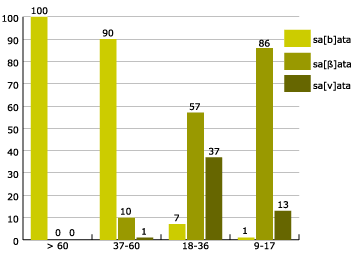
This variant is on
the way out. It is not reflected in the spelling, is not found in Spanish in intervocalic
position, and does not occur in most varieties of Catalan, the standard included.
More surprising is
the occasional realisation from scattered individuals in the southern Valencian counties
of a labiodental v instead of b. This is not simply anecdotal. We are aware,
however, that the semiformal interview setting could have increased its use, since it
would seem to be a hypercorrection. The influence of neighbouring Murcia cannot be ruled
out, where the change [b] > [v] is well known.
This [v] is
variably produced by the adults, but only 37% of the time among young adults. Its use
drops among school students to a discrete 13%. It is heard more from the Lval
group, where there is a conscious tendency to correction —in the semiformal
questionnaire situation— but perhaps they are not as aware as the Eval group
as to when there is a v or a b, thus leading to hypercorrection:
Figure
27. Percentages by type of syllabus, of the realization of intervocalic b: sabata
(shoe)
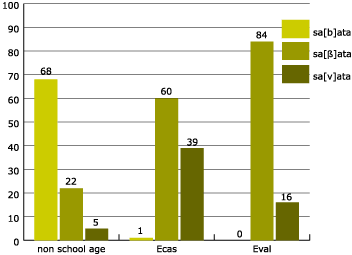
2.13 Final -r
Here we need to
distinguish two situations with relation to the state of final –r in Baix
Vinalopó: a) in the infinitives in absolute final position; and b) and córrer
("to run").
a) In
infinitives in absolute final position we find systematic loss of –r in Crevillent,
where it occurs in responses at 95%. There is a slight recovery of the trill among
schoolchildren who produced it 25% of the time (see figure 28). The Eval group (see figure
29) shows this tendency to a much greater degree than the other group —90% as against
32%.
Figure 28. Percentage by age of
non-deletion of final r in Crevillent: tancar (shut) |
|
Figure 29. Percentage by school
syllabus of non-deletion of final r in Crevillent: tancar (shut) |
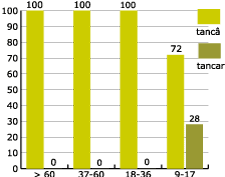 |
|
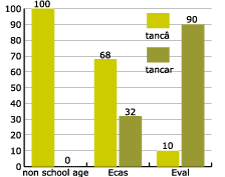 |
The presence of
this phoneme in Spanish, in most of the spoken varieties current in the Valencian Country
—whether colloquial or standard— and in the spelling of both languages strongly
supports recovery of the r at Crevillent, at least —let us remember— in a
questionnaire situation.
Trends in general
Valencian do not support this pronunciation. It is not even clearly acceptable in
different manuals of pronunciation, so that most teachers are unlikely encourage the
preservation of this feature of Crevillent speech.
b) We need
to comment separately on a verb that shows generalised loss of final –r in the
traditional model throughout the county, Guardamar excepted; the verb in question is
córrer which is pronounced corre by 64% of respondents overall —with the exception
of Guardamar:
Figure 30. Percentage by age of
non deletion of final r: córrer (run) |
|
Figure 31. Percentage by type of school
syllabus of non deletion of final r: córrer (run) |
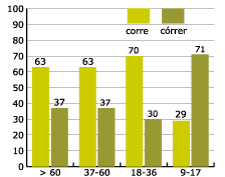 |
|
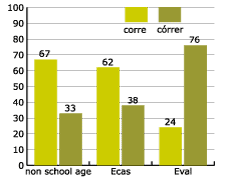 |
Maintenance of the
variant with deletion of the trill is solid across the three adult generations. Indeed,
the young adults actually show a slight increase in r-less responses.
A factor here must
be dissimulation, after the preceding -r-. School pupils, however, reverse this
trend quite dramatically and reintroduce the sound -r 71% of the time (see figure
31). So once again it is the school agers, and with similar results to the preceding
instance discussed above, who reintroduce the feature in a decided way, above all in the
case of the Eval group.
In short,
reintroduction of the final –r final where the traditional model had lost it
is substantial, and especially so in the case of the Eval group. At the same time
the preceding generations also show some reintroduction.
2.14 General trends observed on the phonetic level
The grouping of
data as done above provides as with an overview of the combined phonological trends and
tendencies in the county of Baix Vinalopó. Recall that we have considered two fundamental
axes: the maintenance or otherwise of the traditional model as against the degree of
progress made by innovations. Working with these two axes, we set out to consider the
following factors: firstly, the degree of incidence of the majority language
—Spanish— on the local language model in the county; secondly, the extent of
incorporation of innovations stemming from the standard models of the Catalan language;
and, finally, the degree of diversification of the language of the county owing to
internal factors (coming neither from Spanish nor standard Catalan).
a) As can
be seen in figure 32, the phonetics of Spanish progressively effect the local model of
language in a perceptible way over apparent time. The school-aged group show this to the
greatest extent. The Eval factor (education through the medium of Catalan/Valencian) has
not succeeded in putting a brake on this trend, since this group produce
"Spanish-isms" to the same degree as the Lval group. The very slight change of
direction that can be seen in the language model of the Eval group does not reach
significance, although it needs to be borne in mind and valued positively:
Figure
32. Innovations coming from Spanish (non normative)
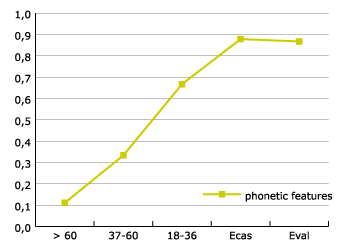
b) The
repercussions in phonetic terms of the standard models of language can be seen to be
related systematically to the age variable (logically enough with the factors in play
here, including longer contact with schooling and with the mass communication media). The
number of innovations introduced from standard is growing, as we can see in figure 33.
Furthermore, school in general, and above all the Eval curriculum, is of key importance in
this instance. Even so, the traditional phonetic model coinciding with the standard one
shows quite a sharp retreat, as figure 34 shows. It can be seen that, in this case, Eval
does not seem capable of reversing the trend.
Figure 33. Normative innovations |
|
Figure 34. Genuinely traditional,
normative forms |
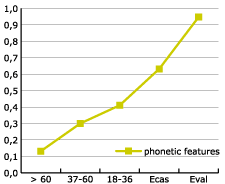 |
|
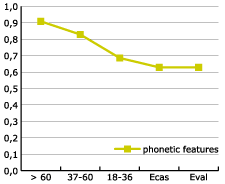 |
c) Lastly,
features belonging to the traditional model which are genuine but not features of the
standard language, are destined to disappear. Their days are numbered, as can be seen in
figure 35. On the other hand, innovations not due to any external factor (see figure 36)
show substantial growth in the generation aged between 37 and 60. Growth slows down in the
case of the young adults, and in the case of school children, especially those in the Eval
category, features of this sort are avoided. |
